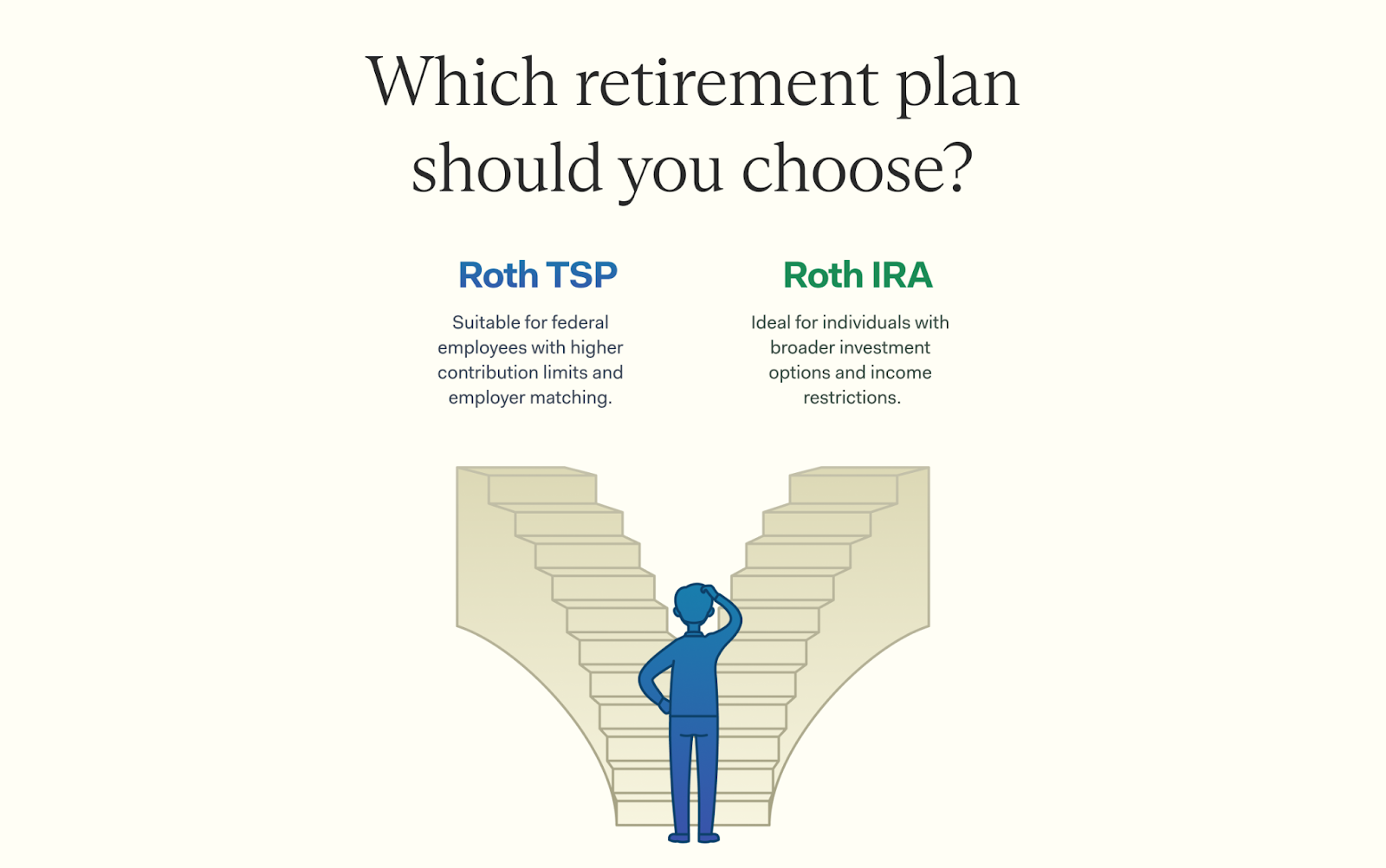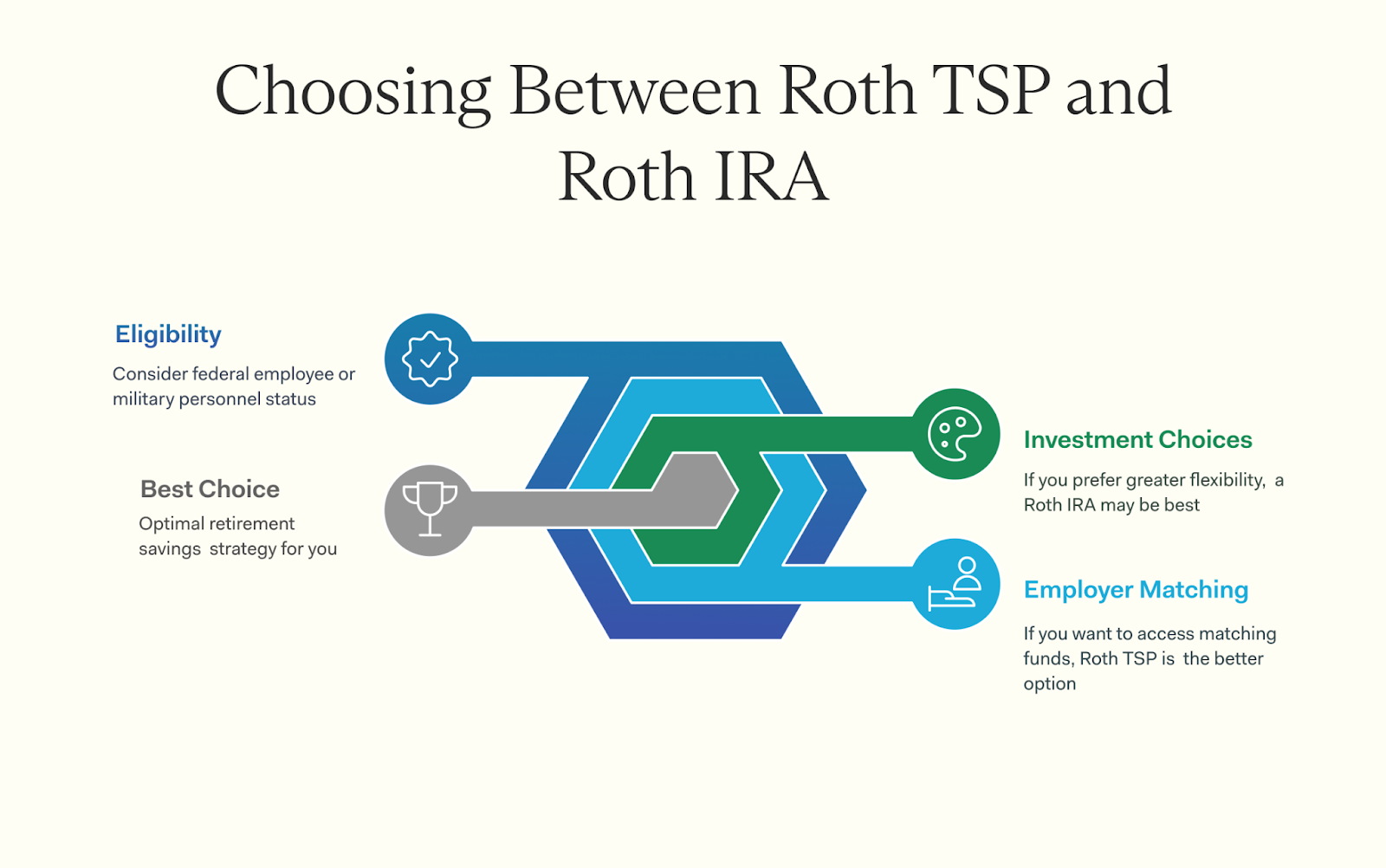Compare Roth TSP and Roth IRA to find out which retirement savings option suits you best. Read the article for a clear analysis and make informed choices.
Deciding between a Roth TSP and a Roth IRA is important for growing your retirement savings. Both offer tax-free withdrawals and use after-tax dollars. But they cater to different people.
A Roth TSP is available for federal employees, including military personnel. On the other hand, anyone earning an income can start a Roth IRA. This guide aims to clear up the differences and benefits of each plan to help you choose the right one for your retirement strategy.
Understanding these plans could mean more substantial retirement savings down the line. So let's examine what sets them apart and how they can fit into your future financial planning.

The Thrift Savings Plan (TSP) is a retirement savings plan for federal employees, including military members. It's part of the Federal Employees Retirement System. With this plan, you invest money after paying taxes on it.
So, when you retire, you can withdraw your money without paying taxes again.
This account is special because it lets your savings grow tax-free and allows tax-free withdrawals later on. Plus, if your employer matches some of your contributions to the Roth TSP—like many do—it boosts your retirement savings even more.
The Roth TSP has higher contribution limits compared to most other retirement accounts. This means federal employees have a good chance to save more for retirement with these plans. Also, by investing in a Roth TSP along with getting matching funds from employers, workers see their savings increase faster due to compound growth over time.
Roth IRAs allow for retirement savings with after-tax dollars, meaning taxes are paid before contributions.
These accounts are available through banks, brokers, or mutual fund companies but have income-based contribution limits.
Withdrawals after 59 and a half are generally tax-free, covering both contributions and earnings, provided they also meet the five-year holding period requirement.
Roth TSPs share these tax-free growth benefits. However, unlike Roth IRAs, Roth TSPs are subject to required minimum distributions (RMDs) starting at age 72. Both plans use after-tax dollars for contributions, aiming to secure a comfortable retirement without additional tax burdens on withdrawals.
This makes Roth IRAs and Roth TSPs attractive for their significant tax advantages in retirement planning, albeit with some key distinctions.
Both the Roth TSP and Roth IRA share key features like tax-free withdrawals and contributions made with after-tax dollars. It's important to note that the Roth TSP is available exclusively to federal employees and members of the uniformed services, whereas the Roth IRA is available to anyone with earned income, subject to income limits. Want to know more? Keep reading!
Tax-free withdrawals are one of the best benefits of a Roth TSP and a Roth IRA. With both plans, you can take money out without paying taxes on that amount. This is great for your retirement savings.
You grow your investments tax-free as well.
You make contributions with after-tax dollars in both accounts. That means you've already paid taxes on that money before putting it in. Once you've met all the rules, withdrawals become tax-free.
This includes the earnings too! Both plans help you keep more money during retirement... which is key to a secure and comfortable future.
For 2025, individuals under 50 can contribute up to $23,500 to their Roth TSP, and those 50 or older can contribute up to $31,000, including catch-up contributions.
In contrast, the annual contribution limit for a Roth IRA is $7,000 if you're under 50, and those age 50 and above can add another $1,000 as a catch-up, totaling $8,000.
For Roth IRAs, single filers with a modified adjusted gross income (MAGI) that phases out between $150,000 and $165,000 may not be able to contribute at all. For married couples filing jointly, the phase-out range is between $236,000 and $246,000.
This means you pay taxes on the money before you put it into these accounts. The good news is that this leads to tax-free withdrawals later.
You won't owe any taxes on the earnings when you take them out, as long as you follow the rules.
For many, this setup offers a smart way to save for retirement without worrying about future tax bills. With both plans, your savings can grow over time without added tax costs later...
The Roth TSP offers a limited selection of investment options managed by the Federal Retirement Thrift Investment Board, including lifecycle funds and individual funds that invest in government securities, domestic and international stocks, and bonds. These options differ from traditional mutual funds.
While early withdrawals from a Roth TSP are generally subject to taxes and penalties, there are exceptions allowing withdrawals for financial hardship or for those at least 59½ years old and having met the five-year holding period.
Now let's look at what makes each account unique.
These two retirement accounts differ mainly in how much you can contribute and what investment choices you have.
The contribution limits for a Roth TSP and a Roth IRA differ quite a bit. For 2025, you can put in up to $23,500 in your Roth TSP if you are under 50. If you're 50 or older, that limit goes up to $31,000 with catch-up contributions.
In contrast, the annual contribution limit for a Roth IRA is $7,000 if you're under 50. Those aged 50 and above can add another $1,000 as a catch-up, totaling $8,000.
Income affects your ability to contribute too. For Roth IRAs, for 2025, people with modified adjusted gross income (MAGI) over certain amounts may not be able to contribute at all. For single filers, the ability to contribute phases out between a MAGI of $150,000 and $165,000. For married couples filing jointly, the phase-out range is between $236,000 and $246,000. There are no income limits for contributing to a Roth TSP.
Understanding these differences helps when planning your retirement savings strategy. Choose wisely!
Roth TSP and Roth IRA both offer different investment choices. The Roth TSP offers a limited selection of investment options managed by the Federal Retirement Thrift Investment Board, including lifecycle funds and individual funds that focus on government securities, domestic and international stocks, and bonds.
You can pick options that match your comfort with risk.
On the other hand, a Roth IRA gives you more freedom. You can choose from various investments—stocks, bonds, or even real estate. This flexibility helps create a more personalized plan for your retirement savings.
Note: It is also important to note that the Roth TSP is exclusively available to federal employees and members of the uniformed services, in contrast to the Roth IRA, which is available to anyone who has earned income, subject to income limits.
The best choice between a Roth TSP and a Roth IRA depends on your needs. A Roth TSP is great for federal employees. It offers higher contribution limits.
Employers may match contributions too.
A Roth IRA has lower contribution limits. However, it gives you more investment options and flexibility with early withdrawals. If you're looking for significant tax benefits and long-term growth, both plans are valuable but the best choice hinges on your financial goals and situation.
You can contribute to both a Roth TSP and a Roth IRA. Many federal employees use both accounts to boost their savings. A Roth TSP is an employer-sponsored retirement plan for federal workers, allowing contributions through payroll deductions.
It also offers matching contributions from the employer.
A Roth IRA is an individual retirement account that anyone can open. You can put money into it after paying taxes on your income.
Using both options helps you grow tax-free earnings while maximizing your retirement savings.
Military personnel enjoy unique benefits with the Roth TSP. They can contribute the same elective deferral limit as civilian employees.
Moreover, they have the advantage of contributing tax-exempt pay earned in combat zones up to the annual additions limit of $70,000 for 2025 to their traditional TSP accounts, while Roth TSP contributions adhere to the deferred limit applicable to all.
This means military members can save significantly more in after-tax dollars for retirement.
Another perk is employer matching contributions. All federal employees, including military personnel under the Blended Retirement System (BRS), are eligible for employer matching contributions up to 5% of basic pay. This match can boost tax-free earnings withdrawals later on.
Using these tools helps build a secure and comfortable retirement for those who serve our country, plus it offers significant tax advantages not found elsewhere.
When deciding between these two retirement options, consider these key factors:
Your choice will shape your savings strategy. It's important to think carefully before deciding on one option over the other!

Both Roth TSP and Roth IRA offer tax-free withdrawals in retirement, but they differ in contribution limits, investment options, and withdrawal rules.
Understanding these differences can help you maximize your retirement savings strategy.
Need help deciding which is right for you? Speak with a Farther financial advisor to get personalized retirement planning advice!
Roth TSPs and Roth IRAs offer powerful tax advantages that can significantly impact your retirement security. While both provide the substantial benefit of tax-free qualified withdrawals, your personal circumstances—including income level, desired contribution amounts, and investment preferences—should guide your choice between these vehicles.
For many investors, strategically utilizing both options may create the optimal tax-diversified retirement strategy. Consider consulting with a financial advisor to develop a personalized approach that maximizes your retirement savings potential while minimizing your lifetime tax burden.
Roth TSP, or Thrift Savings Plan, is an employer-sponsored retirement plan for federal government employees and those in the civil service retirement system. Contributions are made with after-tax dollars, allowing for tax-free withdrawals upon retirement. On the other hand, a Roth IRA (Individual Retirement Account) offers more tailored investment strategies but has income eligibility restrictions.
For both the Roth TSP and Roth IRA, there are set contribution limits which vary based on factors like age and tax filing status. However, typically, contribution limits for a Roth TSP tend to be higher than those for a Roth IRA.
No—only employee contributions to a Thrift Savings Plan may receive matching contributions from their federal service employer; this does not apply to individual accounts like a traditional or Roth IRA.
Yes—in terms of taxation they offer the same tax-free withdrawals benefits; however different rules apply regarding when you can withdraw earnings tax-free without penalty or required minimum distributions.
Yes—for example your Roth IRA eligibility depends on your taxable income level whereas Roth TSP contributions aren't subject to such restrictions.
Both options offer significant tax advantages—including combat zone tax exclusion—and potential for significantly boosting retirement savings by offering growth that's essentially free of future tax liability... It largely depends on personal circumstances such as whether you're eligible for an IRA account given its restrictions around earnings levels or if you prefer having more control over how funds are invested via various investment options offered under an individual account vs limited ones under TSP.